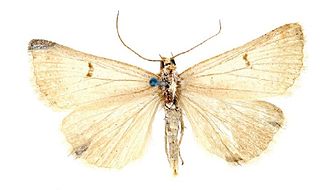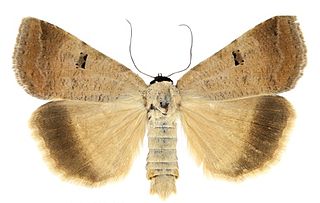
The small angle shades is a moth of the family Noctuidae. It is distributed throughout the Palearctic. The species was first described by Carl Linnaeus in his 1758 10th edition of Systema Naturae.

The herald is a moth of the family Erebidae. The species was first described by Carl Linnaeus in his 1758 10th edition of Systema Naturae. It is found throughout the Palearctic and Nearctic (Holarctic).

Lygephila pastinum, the blackneck, is a moth of the family Erebidae. The species was first described by Georg Friedrich Treitschke in 1826. It is found in Europe and across the Palearctic Siberia, the Russian Far East, Japan and China.

Catocala sponsa, the dark crimson underwing, is a species of moth of the family Erebidae. It is found in Europe, North Africa and from Anatolia up to the Caucasus.

Catocala electa, the rosy underwing, is a moth of the family Erebidae. The species was first described by Karl Friedrich Vieweg in 1790. It can be found in Europe and Asia.

Lygephila is a genus of moths in the family Erebidae. The genus was erected by Gustaf Johan Billberg in 1820.

Catocala nymphagoga, the oak yellow underwing, is a moth of the family Erebidae. It is found in Southern Europe, from Bulgaria up to the Iberian Peninsula and sometimes further north as a migrant. It is also found in North Africa and Asia Minor.

Lygephila craccae, the scarce blackneck, is a moth of the family Erebidae. It is found in temperate Europe and across the Palearctic to the Altai Mountains, Korea, Japan and China.

Lygephila amasina is a moth of the family Erebidae first described by Otto Staudinger in 1878. It is found in Turkey, Lebanon and Israel.

Lygephila pallida is a moth of the family Erebidae first described by Andreas Bang-Haas in 1907. It is found in central and eastern Turkey.

Lygephila fereidun is a moth of the family Erebidae first described by Wiltshire in 1961. It is found in the Elburz Mountains of northern Iran.

Lygephila subpicata is a moth of the family Erebidae first described by Wiltshire in 1971. It is found in northern and western Iran.

Lygephila moellendorffi is a moth of the family Erebidae, genus Lygephila first described by Alfred Otto Herz in 1904. It is found in North Korea.

Lygephila alaica is a moth of the family Erebidae first described by Hans Remm in 1983. It is found in Tajikistan and Uzbekistan.

Lygephila minima is a moth of the family Erebidae first described by Oleg Pekarsky in 2013. It is found in southern Russia and Armenia.

Lygephila lubrica is a moth of the family Erebidae first described by Christian Friedrich Freyer in 1842. It is found from the Zaporizhia region of Ukraine to the Rostov, Samara and Povolzhie regions to the Ural of Russia through Kazakhstan, the Russian Altai to northern Mongolia.

Lygephila kazachkaratavika is a moth of the family Erebidae first described by YuL Stshetkin and YuYu Stshetkin in 1994. It is found in Kazakhstan and Kyrgyzstan.

Lygephila lupina is a moth of the family Erebidae first described by Ludwig Carl Friedrich Graeser in 1890. It is found in the Russian Far East, China and Korea.

Lygephila vulcanea is a moth of the family Erebidae first described by Arthur Gardiner Butler in 1881. It is found in Russia and Japan.
Boryzops purissima is a species of moth of the family Erebidae. It is found in the southern United States, where it has been recorded from Florida and Texas, as well as in Veracruz in Mexico, Costa Rica and Jamaica.




















